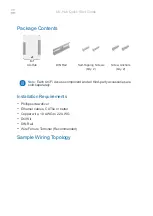
Q7-A29
Q7-A29 - Rev. First Edition: 1.0 - Last Edition: 1.0 - Author: S.B. - Reviewed by G.G. Copyright © 2016 SECO S.r.l.
41
3.2.3.14
Power Management signals
According to Qseven
®
specifications, on the golden card edge connector there is a set of signals that are used to manage the power rails and power states.
The signals involved are:
PWGIN: Power Good Input, +5V_S tolerant active high signal. It should be driven on the carrier board to signal that power supply section is ready and stable.
When this signal is asserted, the module will begin the boot phase. The signal must be kept asserted for all the time that the module is working.
PWRBTN#: Power Button Input, active low, +3.3V_A voltage signal with 10k
Ω
pull-up resistor. When working in ATX mode, this signal can be connected to a
momentary push-button: a pulse to GND of this signal will switch power supply On or Off.
RSTBTN#: Reset Button Input, active low, +3.3V_A voltage signal with 10k
Ω
pull-up resistor. This signal can be connected to a momentary push-button: a pulse
to GND of this signal will reset the Qseven
®
module.
BATLOW#: Battery Low Input, active low, +3.3V_A voltage signal with 10k
Ω
pull-up resistor. This signal can be driven on the carrier board to signal that the system
battery is low, or that some battery-related event has occurred. Can be left unconnected if not used.
WAKE#: Wake Input, active low +3.3V_A electrical voltage signal with 10k
Ω
pull-up resistor. This signal can be driven low, on the carrier board, to report that a
Wake-up event has occurred, and consequently the module must turn itself on. It can be left unconnected if not used.
SUS_STAT#: Suspend status output, active low +3.3V_A electrical voltage signal. This output can be used to report to the devices on the carrier board that the
module is going to enter in one of possible ACPI low-power states.
SUS_S3#: S3 status output, active low +3.3V_A electrical voltage signal. This signal must be used, on the carrier board, to shut off the power supply to all the
devices that must become inactive during S3 (Suspend to RAM) power state.
SUS_S5#: S5 status output, active low +3.3V_A electrical voltage signal. This signal is used, on the carrier board, to shut off the power supply to all the devices
that must become inactive only during S5 (Soft Off) power state.
SLP_BTN#: Sleep button Input, active low +3.3V_A electrical level signal, with 10k
Ω
pull-up resistor. This signal can be driven, using a pushbutton on the carrier
board, to trigger the transition of the module from Working to Sleep status, or vice versa. It can be left unconnected if not used on the carrier board.
LID_BTN#: LID button Input, active low +3.3V_A electrical level signal, with 10k
Ω
pull-up resistor. This signal can be driven, using a LID Switch on the carrier board,
to trigger the transition of the module from Working to Sleep status, or vice versa. It can be left unconnected if not used on the carrier board.
3.2.3.15
Miscellaneous signals
Here following, a list of Qseven
®
compliant signals that complete the features of Q7-A29 module.
SMB_CLK: SM Bus control clock line for System Management. Bidirectional signal, electrical level +3.3V_A with a 2k2
Ω
pull-up resistor. It is managed by AMD G-
series SOC
’
s System Management Bus controller.
SMB_DAT: SM Bus control data line for System Management. Bidirectional signal, electrical level +3.3V_A with a 2k2
Ω
pull-up resistor. It is managed by AMD G-
















































